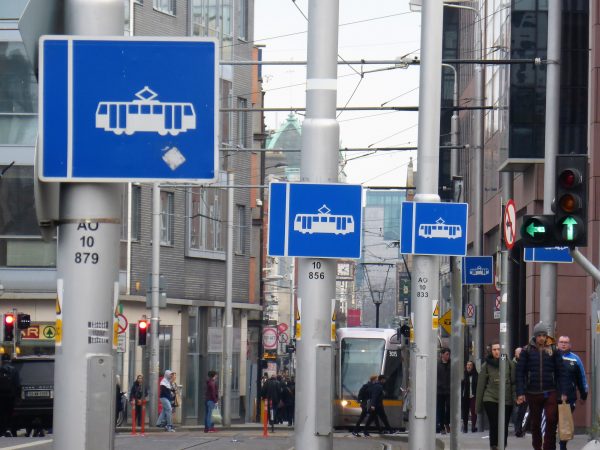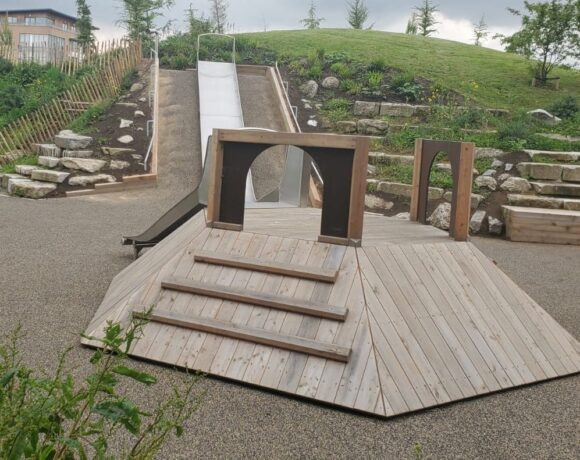The proliferation of traffic signs on the streets of Ireland’s towns and cities seems to only multiply each year. But are these signs servicing any purpose beyond pleasing regulators? Urban Planner Stephen Coyne, discusses why less is often more.
A serious addiction crowds the streets of our towns and cities. You can hardly walk down the average thoroughfare with ease without being assaulted by the effects of this addiction: they seem to be everywhere. They gather on corners and junctions, clog-up our footpaths and even litter our parks and open spaces. And it’s an addiction that’s costing you a pretty penny.
Our urban centres are addicted to metal. Not the dulcet tones beloved of angry men in black, but the ever-increasing plague of signage poles, bollards and assorted municipal clutter that masquerades under the euphemistic title of ‘street furniture’.
Observe the average street and chances are you’ll see a forest of galvanised steel before you see a tree. You’ll be corralled along the street by ranks of bollards and guardrails, taking the place of your common sense and hemming you in from seemingly near certain death on the carriageway. Every possible action you could take as a pedestrian, certainly as a driver, will be dictated by a sign, or two for good measure, or three if the message needs ramming home.
Municipal signage is a necessity of course. City streets are complex, and the more intensive the use of the street the more complex it becomes. We need signs to announce speed limits, and regulate parking, and direct traffic. But do we need so many of them? Do all these signs help? Are they effective? Can the average driver or street user absorb all these messages while safely negotiating the roadway in front of them? What about those of us on foot, trying to negotiate what should be public space.
The affliction of street furniture is common to all Irish urban areas, although some show more restraint than others. However, it would appear that Dublin takes to its addiction with more enthusiasm than is seemly. On most streets, there is a pole every five metres or so. Doubling up is the accepted practice. The simplest T-junction can be governed by up to 30 signs.
You’re approaching the bus lane; you’re on the bus lane; you’re still on the bus lane. Urban set-pieces are blighted by them. Even fully pedestrianised streets have an unhealthy dose of ‘no entries’ and ‘pedestrian zones’ and ‘no right turns’. The concept of self-governing, people-centred streets seems more distant than ever.
Every urban initiative comes with a plethora of signs. The last big splurge came in late 2013 when ‘no entry’ signs were mandated for use on Irish streets. In Dublin, the traffic engineers took to the challenge with gusto, and poles and signs appeared on every street. There were even signs to warn you of the blindingly obvious (don’t drive on the wrong side of the street!). We are in the throes of the next splurge, arising from the new 30km speed limits being introduced to most of the city centre within the canal ring. And later this year, the new Luas Cross City will arrive with its own set of signs and people management measures (observe the Red Luas line as it runs along Abbey Street).
Street furniture does not come cheap. The average bollard costs in the region of €200 to purchase and install, and a signage post is approximately €500. Multiply this by the number found on the average street and then consider the city-wide cost of thousands of streets. Of course, street furniture is being added and subtracted all the time and so the spending on it by local authorities can be hard to pin down. It’s difficult to get a full measure of the financial cost to a city or county of street furniture, or to appreciate the value of these ‘assets’.
The cost to our streetscapes is harder to quantify. However, it is increasingly recognised in city plans and strategies. ‘It’s time to declutter’ – a simple but succinct statement in the first Dublin City Public Realm Strategy, adopted by the city in 2013, which was meant to signal a new approach to that most unvalued city asset, the public realm. The strategy recognised a problem: ‘There has been a proliferation of street furniture, signage and other forms of street clutter in recent years. Some of this is in response to legal requirements; some is caused by low controls on informal installations and signage. This clutter has negatively affected the accessibility of spaces and their visual quality. Removing or reducing clutter where possible would contribute positively to the public realm.’
Our ability to create an attractive, quality, pedestrian-focused environment in the city is being compromised by the amount of ‘stuff’ being added to streets. Policies appeared in the City Development Plan, local plans, and initiatives seeking restraint, but the requirement of a sign for every action usually overrides these progressive policies. In fairness to local authorities, the requirement comes from higher up the chain, from a Department of Transport that seems to give little thought to the aesthetic of the decisions it makes. And, one might suggest, to the resultant levels of safety. Surely the proliferation of signage in our urban centres is causing a serious and underappreciated safety issue on streets, with road users, whether pedestrians, cyclists or cars, being bombarded with messages. The law of diminishing returns applies here: the more signs there are, the less effective they become.
We need to adopt a more critical and discerning attitude to this issue before it damages more than the aesthetics of our towns and cities. As with so much of our urban transport policy, we tend to mimic the UK. However, the UK has moved away from simply adding more and more unnecessary signage while hoping that the message sinks in. The average London street is a paragon of uncluttered calmness compared to Dublin, even though London is far bigger and far busier than our main city. Neither is the Irish penchant for clutter shared by our continental cousins. Most European cities have figured out how to balance necessary regulation with street quality
Isn’t it time we got a little cleverer with how we regulate our streets? Let’s ditch the metal and enjoy space for space’s sake. And maybe even plant a tree or two.
Stephen Coyne is an urban planner based in Dublin.
The opinions expressed in this article are the personal views of the author and do not reflect those of his employer or agencies he deals with.
This article first appeared in Architecture Ireland as part of their #AIextra series. It can be found at: www.architectureireland.ie/decluttering-dublin













